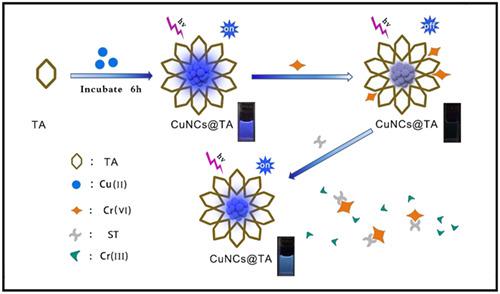当前位置:
X-MOL 学术
›
Luminescence
›
论文详情
Our official English website, www.x-mol.net, welcomes your
feedback! (Note: you will need to create a separate account there.)
‘Turn‐off’ fluorescence strategy for determination of hexavalent chromium ions based on copper nanoclusters
Luminescence ( IF 3.2 ) Pub Date : 2020-08-25 , DOI: 10.1002/bio.3942 Xueling Cao 1 , Yageng Bai 1 , Faxian Liu 2 , Fei Li 1 , Yanan Luo 1
Luminescence ( IF 3.2 ) Pub Date : 2020-08-25 , DOI: 10.1002/bio.3942 Xueling Cao 1 , Yageng Bai 1 , Faxian Liu 2 , Fei Li 1 , Yanan Luo 1
Affiliation

|
Cu nanoclusters (CuNCs) capped by tannic acid (TA) (CuNCs@TA) can be used as a highly sensitive fluorescent probe for Cr(VI) detection. Therefore, a fluorescence detection method for Cr(VI) can be established according to the fluorescence quenching of CuNCs@TA that is caused immediately after the addition of Cr(VI). The fluorescence quenching efficiency of CuNCs@TA was linearly correlated with Cr(VI) concentration within the range 0.03–60 μM, and the detection limit for Cr(VI) was 5 nM. This method was demonstrated to be suitable for detecting Cr(VI) in actual water samples. We found that sodium thiosulfate (ST) can redox with Cr(VI) and therefore restore the fluorescence of CuNCs@TA. The mechanism of CuNCs@TA fluorescence quenching and enhancement by Cr(VI) and ST was investigated in detail. The ‘turn‐on’ fluorescent sensor is of practical significance and has broad application prospects.
中文翻译:

基于铜纳米团簇的“关闭”荧光策略测定六价铬离子
鞣酸(TA)(CuNCs @ TA)覆盖的Cu纳米簇(CuNCs)可用作检测Cr(VI)的高灵敏度荧光探针。因此,可以根据添加Cr(VI)后立即引起的CuNCs @ TA的荧光猝灭来建立Cr(VI)的荧光检测方法。CuNCs @ TA的荧光猝灭效率与Cr(VI)浓度在0.03–60μM范围内线性相关,并且Cr(VI)的检出限为5 nM。事实证明,该方法适用于检测实际水样中的Cr(VI)。我们发现硫代硫酸钠(ST)可以与Cr(VI)氧化还原,因此恢复CuNCs @ TA的荧光。详细研究了Cr(VI)和ST对CuNCs @ TA荧光猝灭和增强的机理。
更新日期:2020-08-25
中文翻译:

基于铜纳米团簇的“关闭”荧光策略测定六价铬离子
鞣酸(TA)(CuNCs @ TA)覆盖的Cu纳米簇(CuNCs)可用作检测Cr(VI)的高灵敏度荧光探针。因此,可以根据添加Cr(VI)后立即引起的CuNCs @ TA的荧光猝灭来建立Cr(VI)的荧光检测方法。CuNCs @ TA的荧光猝灭效率与Cr(VI)浓度在0.03–60μM范围内线性相关,并且Cr(VI)的检出限为5 nM。事实证明,该方法适用于检测实际水样中的Cr(VI)。我们发现硫代硫酸钠(ST)可以与Cr(VI)氧化还原,因此恢复CuNCs @ TA的荧光。详细研究了Cr(VI)和ST对CuNCs @ TA荧光猝灭和增强的机理。











































 京公网安备 11010802027423号
京公网安备 11010802027423号